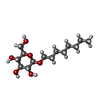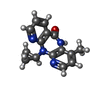+Search query
-Structure paper
| Title | High-resolution view of HIV-1 reverse transcriptase initiation complexes and inhibition by NNRTI drugs. |
|---|---|
| Journal, issue, pages | Nat Commun, Vol. 12, Issue 1, Page 2500, Year 2021 |
| Publish date | May 4, 2021 |
 Authors Authors | Betty Ha / Kevin P Larsen / Jingji Zhang / Ziao Fu / Elizabeth Montabana / Lynnette N Jackson / Dong-Hua Chen / Elisabetta Viani Puglisi /  |
| PubMed Abstract | Reverse transcription of the HIV-1 viral RNA genome (vRNA) is an integral step in virus replication. Upon viral entry, HIV-1 reverse transcriptase (RT) initiates from a host tRNA primer bound to the ...Reverse transcription of the HIV-1 viral RNA genome (vRNA) is an integral step in virus replication. Upon viral entry, HIV-1 reverse transcriptase (RT) initiates from a host tRNA primer bound to the vRNA genome and is the target of key antivirals, such as non-nucleoside reverse transcriptase inhibitors (NNRTIs). Initiation proceeds slowly with discrete pausing events along the vRNA template. Despite prior medium-resolution structural characterization of reverse transcriptase initiation complexes (RTICs), higher-resolution structures of the RTIC are needed to understand the molecular mechanisms that underlie initiation. Here we report cryo-EM structures of the core RTIC, RTIC-nevirapine, and RTIC-efavirenz complexes at 2.8, 3.1, and 2.9 Å, respectively. In combination with biochemical studies, these data suggest a basis for rapid dissociation kinetics of RT from the vRNA-tRNA initiation complex and reveal a specific structural mechanism of nucleic acid conformational stabilization during initiation. Finally, our results show that NNRTIs inhibit the RTIC and exacerbate discrete pausing during early reverse transcription. |
 External links External links |  Nat Commun / Nat Commun /  PubMed:33947853 / PubMed:33947853 /  PubMed Central PubMed Central |
| Methods | EM (single particle) |
| Resolution | 2.8 - 3.1 Å |
| Structure data | EMDB-22899, PDB-7kjv: EMDB-22900, PDB-7kjw: EMDB-22901, PDB-7kjx: |
| Chemicals |  ChemComp-MG:  ChemComp-BOG:  ChemComp-EFZ:  ChemComp-NVP: |
| Source |
|
 Keywords Keywords | viral protein/RNA / reverse transcriptase / RNA / protein-RNA complex / tRNA / polymerase / viral protein-RNA complex / VIRAL PROTEIN |
 Movie
Movie Controller
Controller Structure viewers
Structure viewers About Yorodumi Papers
About Yorodumi Papers










 human immunodeficiency virus 1
human immunodeficiency virus 1 homo sapiens (human)
homo sapiens (human)